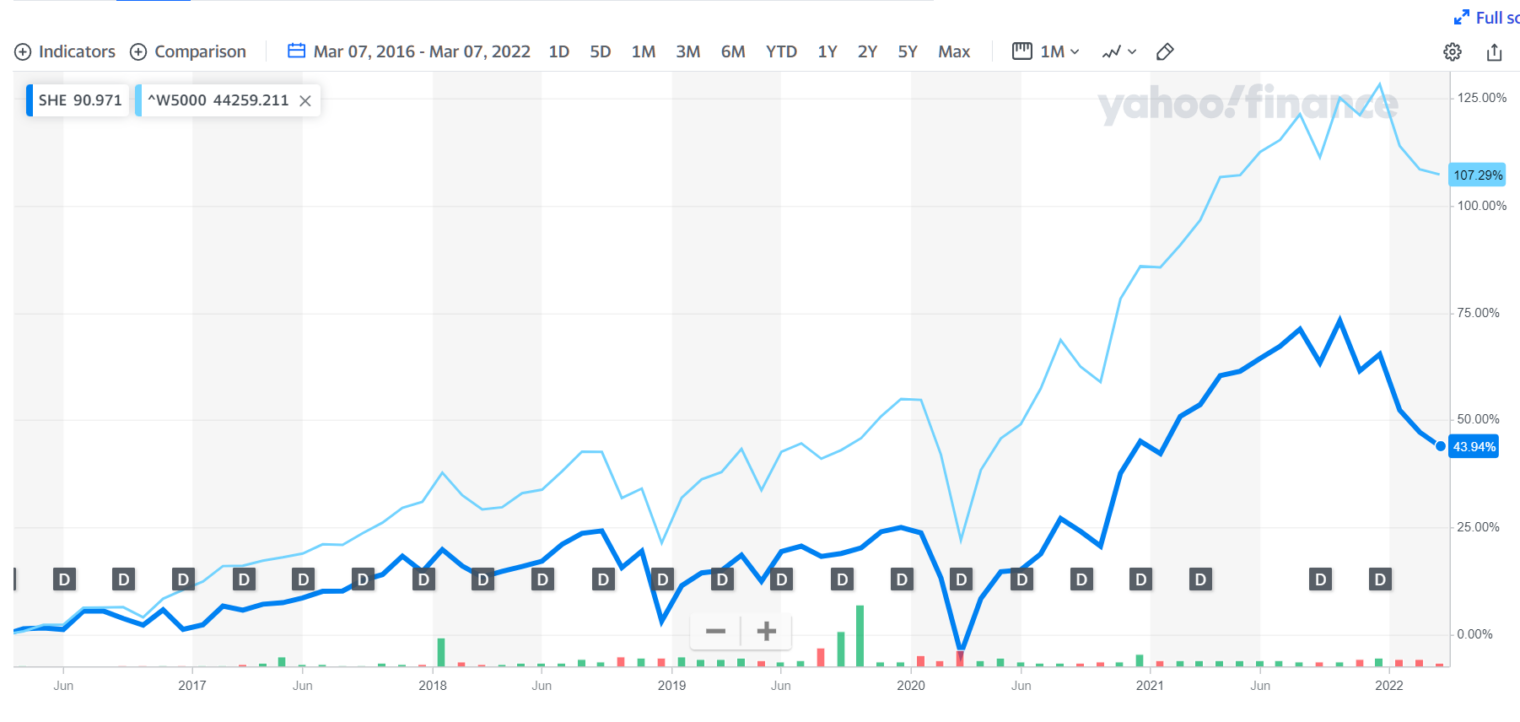Happy 6th birthday to the SSGA Gender Diversity Index ETF (symbol: SHE):
Seeks to provide exposure to US companies that demonstrate greater gender diversity within senior leadership than other firms in their sector
Companies in the Index are ranked within each sector by three gender diversity ratios
The Index seeks to minimize variations in sector weights compared to the composition of the index’s broader investment universe by focusing on companies with the highest levels within their sectors of senior leadership gender diversity
There are nearly 200 holdings in the fund out of the roughly 3,500 significant publicly traded U.S. companies (Wilshire 5000, in which 3,500 is the new 5,000). In other words, roughly 5 percent of U.S. public companies do things the correct (gender diverse) way.
To celebrate Dr. Marissa Mayer‘s brave stewardship of Yahoo! (history, which included 30 days of daily new logos in 2013) we should get a custom chart comparing SHE to the Wilshire 5000 over the past 6 years from Yahoo! Finance.
The stocks of companies that failed to enter the gender diversity Olympics were up by roughly 107 percent in nominal dollars (but don’t forget that inflation eroded these gains; a house in our Florida neighborhood has gone up in price by much more than 107 percent in the same period and even the government’s cooked CPI number is up roughly 20 percent). Stocks of companies with people identifying as “not men” in leadership positions were up by 44 percent.
Related:
- Mediocre: The Dangerous Legacy of White Male America by Ijeoma Oluo (this was prominently featured in the Boulder, Colorado bookstore)
- “Research: Women Score Higher Than Men in Most Leadership Skills” (Harvard Business Review, 2019): … women scored at a statistically significantly higher level than men on the vast majority of leadership competencies we measured.
- “More women in the boardroom could drive higher credit ratings and stock returns for firms — they still hold just 29% of seats” (CNBC, March 11, 2022) says that 107 percent is actually lower than 44 percent. “Anecdotally, the stocks of companies with low female board representation have underperformed.”


Also interesting is the share price of IBM with a peak of $200 when Ginni Rometti took over as CEO in 2012 (she left in 2020 to be replaced by yet another Indian CEO: https://www.nytimes.com/2020/01/30/technology/ginni-rometty-ibm-ceo.html). It is now at $125.
Are women any better at running large companies then landing on aircraft carriers?
It might be that companies in decline are less particular about their choice of CEO. i.e. the causation is backwards
MattyH: It is not only the CEO job that can benefit from the touch of a person who identifies as “not a man”. See page 10 of https://www.ssga.com/library-content/pdfs/ic/self-indexing-ssga-gender-diversity-index-methodology.pdf
“ratio of female executives and female members of the board of directors to all
executives and members of the board of directors;” is one criterion, for example.
If Hunter Biden had identified as a “woman” while serving on the board of Burisma, for example, that would have given Burisma a bump in its gender diversity score.
Since sexism can be defined by outcomes, it may be that capitalism is sexist.
This all is sooo unsuprising given that CEOs are outliers (i.e. on the far right of the bell curve) — not necessarily IQ (but decent IQ – 115-120 or so is pretty much required), but, let’s say aggressiveness and political acumen.
It all boils down to biology: since females are critical to population reproduction (males… not so much) the selective pressure is to make female phenotype less variable and more conservative. Nature experiments on males; the variance of phenotypic traits is significantly greater. Closer to the median it creates little dofference, on shoulders (2 sigmas and more) this creates large difference in frequency (the further from median, the more… at “genius” levels of IQ it’s order of magnitude at least).
This explains completely and quantitatively adequately the difference in sex frequecy in both execitive offices and prisons (on the other shoulder of bell curves… something no feminists are willing to talk about in their quest towards sex equavilty).
So… companies which seek to redress this biological “inequality” with some criteria other than competence and aptitude for the job face much smaller pool of competitive candidates, and so, out of necessity, must lower their standards for females. Which impacts the performance.
Go woke – go broke. Rebellion against the nature is never successful – the nature will win.